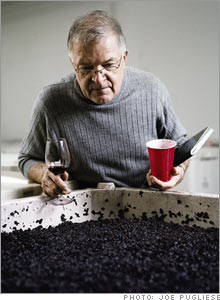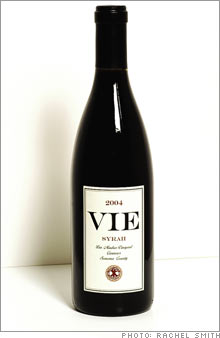A backyard vineyard that makes wine - yoursA Web startup serves that fundamental need of all successful executives: making their very own high-end wines.(Fortune Magazine) -- One weekend morning in 2002, Michael Brill had the sort of epiphany that commonly befalls successful businesspeople - particularly tech businesspeople who live in the San Francisco Bay Area. Fed up with an unfulfilling career in software marketing, Brill wanted to wake up, look out over a vineyard and spend his days handcrafting wine. Unlike many of those who have had the daydream before him, however, he didn't have the, oh, $15 million to plant a stake in Napa or Sonoma. So he got creative. "I dug up my backyard," Brill says, referring to his 625-square-foot plot in San Francisco's sunny Potrero Hill neighborhood. "There was an avocado tree, a lemon tree. I just razed the whole thing and planted pinot noir and a couple of syrah vines."
Over the next year he buried himself in winemaking books, replaced the junk in his garage with a few stainless-steel tanks and a couple of fermenters, and began meeting farmers and procuring grapes. He still had the day job, but by night and on weekends he was living his dream. And suddenly he had a lot more friends. "Random people walking down the street would drop in and say, 'What are you doing?' I'd give them some pizza and beer, and they'd help me for 12 hours," the 41-year-old Brill recalls. "We made some nice wine. And then I knew I wanted to do this in a bigger way." Thus Crushpad was born. Headquartered in a 17,000-square-foot warehouse on a gritty edge of the Mission District, Crushpad is a custom winemaking facility that taps into that universal human urge to give it all up for a life among the vines - without the giving-it-all-up part. At a fraction of the cost and effort of buying land or ripping up the backyard, customers work elbow-deep in grapes and, with the help of a team of professional winemakers, custom-craft their own vintages. Some buy in to get a quality wine at a fraction of the retail cost. Others consider the experience an apprenticeship, an on-ramp to a career change. Many just want a bottle with their name on it to give to clients and family. Whatever their motivation, Crushpad's 1,500 customers are now following Brill's charge toward Wine 2.0, which shares all the buzzy characteristics of "Web 2.0" - social networks, user collaboration, wikis and so forth. The difference, of course, is that whereas Web 2.0-ers drink the proverbial Kool-Aid, Crushpad customers get to enjoy an actual adult beverage. Hands-on winemaking Here's how it works. Let's say you have a thing for Russian River Valley pinot noirs, the earthy, fruit-forward reds that can sell for more than $100 a bottle - if you can find them. Crushpad requires a one-barrel minimum, which is the equivalent of 25 cases. If you want it all to yourself, you drop roughly $6,000, and Brill and his team begin searching out the grapes that - coupled with some hard work and guidance - will turn into your ideal wine. If you're not up for 300 bottles, you sign on with a few friends or search crushnet.com for other people with the same hankering. From there, you can be as hands-on as your time and enthusiasm allow. "In the most disinterested customer scenario, you can call and say, 'I want a barrel of your best cabernet; give it to me in two years,'" says Brill, who one October evening wears the weary mien of a farmer up past his bedtime. Fluent in both MBA-speak (market caps) and wine geek (submerged caps), he explains that Crushpad exploits inefficiencies in the wine supply chain. "This is about a redistribution of costs and margins. We get rid of the retailer and distributor and push the product risk to the community, which provides the cash and the brand development and pays only 40 to 50 percent of what they'd pay at retail." In other words, in Brill's model the middlemen get, well, corked. Despite the value message, Brill isn't after the jug-wine demographic. He's going for the luxury end of the market (about $50 a bottle and up) and offering an experience that can entail everything from chatting up the farmer while the fruit is hanging in the late-summer Napa sun to harvesting, pressing, barreling, bottling, labeling and even commercializing the wine. The Crushpad crew regularly posts fermentation readings on the site for the scrutinizing masses. The company produces about 15,000 cases of more than 400 different lots of wine, and after three harvests, it's already producing some impressive product. One customer recently scored a 91 on a 100-point scale; two others won gold medals in wine competitions. Some of the wines formulated by Bryan Kane, a tech executive and Crushpad customer, can be found at fancy restaurants around San Francisco. "If you start out with excellent grapes," Brill says, "anyone can make good wine." The right place at the right time Crushpad has benefited from stellar harvests in California during the past few years. But Brill says his model works even when there's not a glut of great fruit on the market. Free of the complexity and expense of dealing with distributors and retailers, he can pay a lot more for great fruit. "The farmers spend 12 months tending the vines, and the winery gives them $3,500 a ton, or about $5 for a bottle that'll eventually sell to the consumer for $50," he says. "We could pay all our growers $7 a bottle, or $5,000 a ton, and turn around and say to our customers, 'You're going to have to pay $2 more a bottle.' They know that if we pay more for fruit, they pay more, but they get a higher-quality product." All over the Web, startups are exploiting an increased interest in wine, driven partly by a stream of studies demonstrating the health benefits of consuming it regularly. The sites connect aficionados and offer personalized guides to the often confusing, insular world of wine. Cellar-Tracker.com allows users to catalog and price their collections while sharing tasting notes and rubbernecking at everyone else's cellars. Another site, called Cork'd, brokers introductions of "drinking buddies" who have similar taste profiles. Wine blogs are everywhere. Crushpad customers do more than talk about wine. They become winemakers in their own right. Chad Thomas, a 36-year-old vice president of private banking with J.P. Morgan, is on his second vintage with Crushpad. One evening in early November he stands arm's length from a forklift as employees lower a bin of high-end Napa Valley grapes into the presser. Last year Thomas made a syrah. This summer he showed it off to friends from business school. "We had a blind tasting of $70 bottles, and I slid in one of my '05s," Thomas says. "It wasn't quite ready, but right away my friends said, 'I want in.'" This year they opted for cabernet sauvignon grapes from the ToKalon vineyard in Oakville, Calif. They're paying about $25 a bottle for fruit that in 2003 produced a wine that tastemaker Robert Parker gave a perfect 100-point score. The natural fear for a novice winemaker would be to spoil such high-quality product, but Thomas seems unconcerned. He and his friends will constantly monitor the Web site to see how the wine is progressing, and they can stop by whenever they want. "This is a word-of-mouth business," he says, smiling, as he takes his first swig of the grape juice that, after 18 months in a French oak barrel, should ferment into his dream vintage. "They're not going to let us mess up." The business of winemaking Crushpad employs four full-time winemakers in addition to Brill, all with oenology degrees and experience working at such vaunted wineries as Opus One and Clos du Val. Brill says two customers have disliked their end products so far, so the company refunded their money - and promptly resold the wine to local restaurants at a profit. The company's revenue quadrupled last year, and Brill expects it to double this year. He is currently closing a $2 million round of financing, much of it from individuals who started out as customers. Brill says that opening branches in other cities - he's aiming for New York and Chicago in 2008 - shouldn't be too hard. "There's not much required in the way of winemaking technology," he says, "but information technology is a different story. It's about tracking styles, goals, acids, yeasts - and then translating all that information to the community. We have more people developing software than we do in full-time winemaking." What do the established winemakers think of this revolutionary in their midst? The consensus seems to be that Brill is overplaying the role of the fruit - but in a benign way. "If it's all about the grapes, then my job isn't really that important," says Richard Bruno, the head of winemaking for Don Sebastiani & Sons and co-owner of Vinum Cellars in Napa. Bruno produces more than 1.8 million cases a year, ranging from a $6 Pepperwood Grove merlot to Vinum's $90 Leaky Lake cabernet. "I think he's oversimplifying a bit, but as long as people are drinking wine, it's good for the industry." Brill doesn't expect to be embraced by the establishment of his adopted industry. He's an outsider trying to strip away inefficiencies and distribute the savings to farmers and consumers. But don't mistake his model for altruism. What started out as a fit of passion in the backyard has become an act of pure capitalism. "This is a social production model for wine," Brill says. "It's the old industrial model vs. the networked economy." ____________________ |
|




